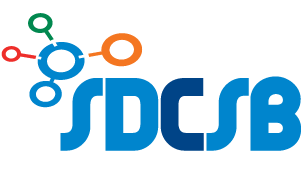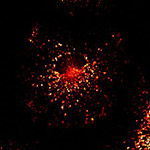Genetics, Bioinformatics and Systems Biology Colloquium
Thursdays, 12:00 pm – 1:00 pm
UC San Diego, Powell-Focht Bioengineering Hall, Fung Auditorium
Complete schedule here
Christopher Putnam, Associate Professor of Medicine, UCSD
Genome Instability and Checkpoint Activation
Using funds provided by the SDCSB, we used a combination of bioinformatics and forward genetic screens to identify genome instability suppressing genes in S. cerevisiae. To determine the effects of genome instability on checkpoint activation, we will screen for genome instability suppressing genes using a highly sensitive marker of checkpoint activation and shutoff – ubiquitin fused to the N-terminus of a destabilized GFP (UBI-Y-GFP) resulting in a fluorescent protein with a half-life of 7 minutes. Our preliminary results suggest that the relationship between genome stability and checkpoint activation is complicated as many mutations have uncorrelated effects on genome stability and checkpoint activation. Once we have identified interesting mutants, we will use the SDCSB microfluidics core to follow checkpoint activation and shutoff in single cells of wild type and mutant strains.
Dieter Wolf, Professor, Sanford Burnham Medical Research Institute
Mechanisms of Oxidative Stress Response
Studies carried out in collaboration with the SDCSB previously suggested that oxidative stress triggers rapid translational shutdown downregulating oxidative stress-suppressed mRNAs thereby liberating ribosome capacity for translation of oxidative stress-induced mRNAs. To test this model in mammalian cells, LNCaP prostate cancer cells will be exposed to SMIP004, which stimulates oxidative stress by inhibiting mitochondrial respiration. System-wide datasets on mRNA and protein abundance, synthesis, and translation will be obtained, modeled, and compared against the yeast oxidative stress model of gene expression. Data mining will include network analysis to define cellular pathways involved. We will also determine the global correlations between mRNA abundance, translation rate and protein abundance and will assemble a mathematical model of SMIP004-mediated gene expression.
Jean Y. J. Wang, Distinguished Professor of Medicine and Biology, UCSD
The Role of Mitochondria in Cancer and Diabetes
Using funds provided by the SDCSB, we found that over-expression of a particular mitochondrial matrix adapter protein caused glucose addiction, a distinguishing feature of cancer cells, and that knock-down of this protein increased insulin sensitivity. In this seed project, we will perform a number of systems-wide analysis including proteomics, metabolomics, lipidomics and sequencing (DNA and RNA) on mitochondria isolated from epithelial cells either overexpressing this protein or with this protein knocked down. Cells will be cultured under glucose-rich or glucose-deprived conditions. We will also perform a screen using CRISPR-knockouts to map the genes that antagonize the effects of this mitochondrial matrix adapter protein on insulin sensitivity; knockouts of downstream effectors should allow MCF10A cells overexpressing this protein to survive under glucose starvation.
Suresh Subramani, Distinguished Professor of Biology, UCSD
Identifying Key Regulators of Autophagy
Autophagy is an important mechanism in eukaryotic cells for recycling proteins and organelles. To describe autophagy on a system-wide level, we generated an autophagy-specific gene interaction network, in part by merging various primary data sets. Within this network, we identified key sub-networks, studied evolutionary conservation, and predicted functionally important nodes. RNAi and an image-based screen were used to validate that CDC42, a Rho GTPase, is a novel regulator of autophagy. This study demonstrated that gene network approaches can provide insights into complex biological systems. Several other candidates, besides CDC42, were identified and we will be pursuing these in more detail.
Publications Supported by These and Previous Seed Grants:
- Abe, Y, Kofman, ER, Ouyang, Z, Cruz-Becerra, G, Spann, NJ, Seidman, JS et al.. A TLR4/TRAF6-dependent signaling pathway mediates NCoR coactivator complex formation for inflammatory gene activation. Proc Natl Acad Sci U S A. 2024;121 (2):e2316104121. doi: 10.1073/pnas.2316104121. PubMed PMID:38165941 PubMed Central PMC10786282.
- Abe, Y, Kofman, ER, Almeida, M, Ouyang, Z, Ponte, F, Mueller, JR et al.. RANK ligand converts the NCoR/HDAC3 co-repressor to a PGC1β- and RNA-dependent co-activator of osteoclast gene expression. Mol Cell. 2023;83 (19):3421-3437.e11. doi: 10.1016/j.molcel.2023.08.029. PubMed PMID:37751740 PubMed Central PMC10591845.
- Davis, AG, Einstein, JM, Zheng, D, Jayne, ND, Fu, XD, Tian, B et al.. A CRISPR RNA-binding protein screen reveals regulators of RUNX1 isoform generation. Blood Adv. 2021;5 (5):1310-1323. doi: 10.1182/bloodadvances.2020002090. PubMed PMID:33656539 PubMed Central PMC7948294.
- Lee, DD, Galera-Laporta, L, Bialecka-Fornal, M, Moon, EC, Shen, Z, Briggs, SP et al.. Magnesium Flux Modulates Ribosomes to Increase Bacterial Survival. Cell. 2019;177 (2):352-360.e13. doi: 10.1016/j.cell.2019.01.042. PubMed PMID:30853217 PubMed Central PMC6814349.
- Chaix, A, Lin, T, Le, HD, Chang, MW, Panda, S. Time-Restricted Feeding Prevents Obesity and Metabolic Syndrome in Mice Lacking a Circadian Clock. Cell Metab. 2019;29 (2):303-319.e4. doi: 10.1016/j.cmet.2018.08.004. PubMed PMID:30174302 PubMed Central PMC7751278.
- Zarrinpar, A, Chaix, A, Xu, ZZ, Chang, MW, Marotz, CA, Saghatelian, A et al.. Antibiotic-induced microbiome depletion alters metabolic homeostasis by affecting gut signaling and colonic metabolism. Nat Commun. 2018;9 (1):2872. doi: 10.1038/s41467-018-05336-9. PubMed PMID:30030441 PubMed Central PMC6054678.
- Zhou, Y, Xu, Z, Quan, D, Zhang, F, Zhang, H, Xiao, T et al.. Nuclear respiratory factor 1 promotes spheroid survival and mesenchymal transition in mammary epithelial cells. Oncogene. 2018;37 (47):6152-6165. doi: 10.1038/s41388-018-0349-2. PubMed PMID:29995872 PubMed Central PMC6329670.
- Sanchez, M, Xia, Z, Rico-Bautista, E, Cao, X, Cuddy, M, Castro, DJ et al.. Oxidized analogs of Di(1H-indol-3-yl)methyl-4-substituted benzenes are NR4A1-dependent UPR inducers with potent and safe anti-cancer activity. Oncotarget. 2018;9 (38):25057-25074. doi: 10.18632/oncotarget.25285. PubMed PMID:29861853 PubMed Central PMC5982742.
- Nene, RV, Putnam, CD, Li, BZ, Nguyen, KG, Srivatsan, A, Campbell, CS et al.. Cdc73 suppresses genome instability by mediating telomere homeostasis. PLoS Genet. 2018;14 (1):e1007170. doi: 10.1371/journal.pgen.1007170. PubMed PMID:29320491 PubMed Central PMC5779705.
- Spahn, PN, Bath, T, Weiss, RJ, Kim, J, Esko, JD, Lewis, NE et al.. PinAPL-Py: A comprehensive web-application for the analysis of CRISPR/Cas9 screens. Sci Rep. 2017;7 (1):15854. doi: 10.1038/s41598-017-16193-9. PubMed PMID:29158538 PubMed Central PMC5696473.
- Jean, S, Kiger, AA. RAB21 Activity Assay Using GST-fused APPL1. Bio Protoc. 2016;6 (4):. doi: 10.21769/BioProtoc.1738. PubMed PMID:28251173 PubMed Central PMC5328668.
- Jean, S, Kiger, AA. VAMP8-3xHA Uptake Assay in HeLa Cells. Bio Protoc. 2016;6 (4):. doi: 10.21769/bioprotoc.1739. PubMed PMID:28251172 PubMed Central PMC5328665.
- Stockwell, SR, Rifkin, SA. A living vector field reveals constraints on galactose network induction in yeast. Mol Syst Biol. 2017;13 (1):908. doi: 10.15252/msb.20167323. PubMed PMID:28137775 PubMed Central PMC5293160.
- Kramer, MH, Farré, JC, Mitra, K, Yu, MK, Ono, K, Demchak, B et al.. Active Interaction Mapping Reveals the Hierarchical Organization of Autophagy. Mol Cell. 2017;65 (4):761-774.e5. doi: 10.1016/j.molcel.2016.12.024. PubMed PMID:28132844 PubMed Central PMC5439305.
- Attali, I, Tobelaim, WS, Persaud, A, Motamedchaboki, K, Simpson-Lavy, KJ, Mashahreh, B et al.. Ubiquitylation-dependent oligomerization regulates activity of Nedd4 ligases. EMBO J. 2017;36 (4):425-440. doi: 10.15252/embj.201694314. PubMed PMID:28069708 PubMed Central PMC5437815.
- Singec, I, Crain, AM, Hou, J, Tobe, BTD, Talantova, M, Winquist, AA et al.. Quantitative Analysis of Human Pluripotency and Neural Specification by In-Depth (Phospho)Proteomic Profiling. Stem Cell Reports. 2016;7 (3):527-542. doi: 10.1016/j.stemcr.2016.07.019. PubMed PMID:27569059 PubMed Central PMC5032292.
- Shah, M, Su, D, Scheliga, JS, Pluskal, T, Boronat, S, Motamedchaboki, K et al.. A Transcript-Specific eIF3 Complex Mediates Global Translational Control of Energy Metabolism. Cell Rep. 2016;16 (7):1891-902. doi: 10.1016/j.celrep.2016.07.006. PubMed PMID:27477275 PubMed Central PMC4988921.
- Fan, JB, Arimoto, K, Motamedchaboki, K, Yan, M, Wolf, DA, Zhang, DE et al.. Identification and characterization of a novel ISG15-ubiquitin mixed chain and its role in regulating protein homeostasis. Sci Rep. 2015;5 :12704. doi: 10.1038/srep12704. PubMed PMID:26226047 PubMed Central PMC4520236.
- Till, A, Saito, R, Merkurjev, D, Liu, JJ, Syed, GH, Kolnik, M et al.. Evolutionary trends and functional anatomy of the human expanded autophagy network. Autophagy. 2015;11 (9):1652-67. doi: 10.1080/15548627.2015.1059558. PubMed PMID:26103419 PubMed Central PMC4590607.
- Hardy, MD, Yang, J, Selimkhanov, J, Cole, CM, Tsimring, LS, Devaraj, NK et al.. Self-reproducing catalyst drives repeated phospholipid synthesis and membrane growth. Proc Natl Acad Sci U S A. 2015;112 (27):8187-92. doi: 10.1073/pnas.1506704112. PubMed PMID:26100914 PubMed Central PMC4500204.













